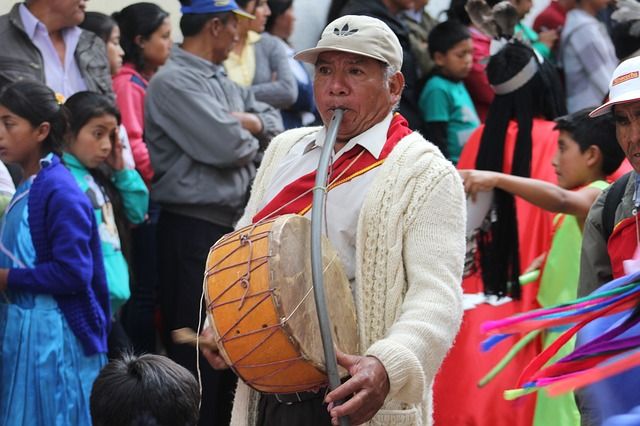The festival of the sun is a celebration that takes place in Cusco, a city in the country of the Incas, Peru and that represents the devotion that this people gave to this god, who is manifested every June 24, marking the winter solstice and this star is farthest from earth.
It is usually called Into Rami in the traditional language of this country, which maintains its traditions rooted from that time to the present day, including that there are still peoples whose beliefs have been maintained in honor of their gods, the four elements of nature..

The Incas were a very superstitious people and for this reason they kept performing different rituals that are going to greatly influence the thinking of the inhabitants today, keeping a large part of their traditions intact without the carnage of which some were the protagonists.
For this reason, the Into Rami or festival of the sun was one of the four festivities that took place at the beginning of the year, during which sacrifices, dance, music, and hubbub were made and thanks were given to the sun god, who was the one who manifested his power. Giving the heat so that their crops bore fruit.
This festival has been maintained as in the past between 9 and 10 days during which different acts are carried out, beginning with the wait for the birth of a new day on this date and especially the appearance of the king star, a wonder for those celebrating this star.
What do you need
- Open minded.
- Enjoy.
- Understanding.
- Find information.
- Pay attention to what is done.
- The colorful.
- Sacrifice.
- Military march.
- hubbub
- Music.
- Beverage.
- Typical Peruvian food.
Instructions
The Into Rami is the festival of the sun for the descendants of the Incas, a noble people born in Peru many centuries ago, but the current population maintains its traditions and for this reason this festival is marked as one of the most important for this village.
The party begins with everything turned off, waiting for the appearance of the sun, by all the villagers who gave thanks for their crops, the light and the heat that gave them hope and that is how the party begins today by who have the initiative to keep this tradition alive.
The presence of the priests, they gave those present in the celebration of thanks to the sun god, and for this, with the help of a piece of gold and a piece of cloth, with the rays of the sun they managed to light a flame that they later maintained without being disturbed. Quench the chosen women for the god.
All about the sun party
- The Into Rami was a special ceremony, vaguely reminiscent of Mexican festivals, which gave thanks to the sun god by the Inca people, who had special adoration for stars and other elements of nature such as water, the sun, the moon, fire among many other things.
- For the celebration of the festivities, the use of the other was widely used to adorn oneself for what is considered a civilization that possessed great wealth in this mineral, which is why many objects made with gold have been preserved today.
- The ceremony of the Into Rami or sun god has been preserved intact to the present day and comes to show the heart of a people whose beliefs are rooted and last until today, despite being prohibited because it is considered a pagan ceremony.
- It is a theatrical performance that evokes the adoration of a traditionalist people determined to maintain their idiosyncrasy through the idealization of what their ancestors did, marking by a deep love for what is done.
- It is important to express the importance of the different troupes headed by the virgin daughters of the Incas, in addition to the wives who were chosen to do special dances that give color to this festivity.
- The typical costume is counteracted by the diversity of costumes that are maintained from the priest to the coy or the must itself, Inca princesses who parade during the festival where the main one is transferred in a litter to start this party.
- To the rhythm of the music, the principal stands up and offers his arms as a sign of respect towards the sun, in addition to the presentation of two vessels made of another cigar, fully filled with a representative liquid for them, such as chichi.
- Despite the fact that the ancient Inca Empire has disappeared, the inhabitants of Peru continue their traditions, making this festival an alternative of color, clothing, typical food and drink, an opportunity for tourism outside the home borders.
- The festival of the sun is also held in Ecuador, but the most representative is that of the city of Sacsayhuamán in the north of Cusco, Peru, in addition to having the possibility of knowing the different crafts and architectural manifestations of the Incas.
- The festival of the sun is usually a request that the Incas make to the god so that he returns the heat of his rays to the earth, the need to heat their crops so that they can occur and the diversity of beliefs that have been maintained over time..
- A kind of delivery and submission is given by the delivery and offering of the whole family through the different characters of the dance itself, the virgins, wives, princesses headed by the main person, who is the Inca or chief of the town.
- One of the ancestors of the Incas was the one who ordered the construction of the city that is used today for the celebration of the festival in the case of Pachakuteq, and it becomes the architectural manifestation of adoration of the king star by the people.
- The Incas used to call the sun Ape Into and its name is maintained today by those who have managed to cultivate this ceremony as a tradition every June 24 in honor of their god the sun, therefore it is a beautiful and full of life manifestation.
- According to their beliefs, the Incas thought they were direct descendants of the sun and therefore parties, rites and sacrifices were held for the same star, and thus thank him for his existence through the offerings that were made during this time.
- In Cusco there are many demonstrations and preparations with which they are characteristic of giving free rein to the diversity of festivities that take place during these dates close to June 24, but whose organization dates back almost to the end of it.
- Each one of the differentiated troupes with the princesses, wives, virgins go forward in large columns revealing their colorful as well as striking costumes, to the rhythm of the music from which the main Inca comes out to give his request to the sun god..
- In the time of the Incas, thanks to their great wealth, the litter was made of gold and leg and today an iconic allegory is maintained that has the colors painted on behalf of these two wonderful metals, in addition to being escorted by the great leaders. And priests.
- The festival is celebrated with the high priest, the representatives of the families that made up the town in general with a variety of forms, as well as the change of places where the different rituals of the celebration to the sun god were performed.
- The main places where these festivities are held are the great Coricancha temple of the sun, the main square and the saqsaywaman, which is a temple to venerate the sun’s rays, therefore these festivities are held in these places today.
- The aforementioned places are sacred to Peruvians who maintain their tradition and devotion to their ancestors, which have made them worthy of being a people with a great culture rich in love for tradition and populism.
- Generally there are many visitors who come to enjoy the great show in each of the sites for the worship of the sun god, in addition to the locals who enjoy the richness of their culture, visitors from many parts of the world.
- The festival of the sun is the most representative act of the culture of Cusco during the month of June, so if you plan to attend or get to know this city, go through this date and take advantage of observing what the Peruvian culture has locked up for you.
- Among the typical dishes that you can taste during this festival is the chi Carron a la coquina, chichi de jota, church, ceviche among many others, the ideal is that you try them all and have an idea of what Peruvians cultivate as national gastronomy..
- Keep something in mind; the Incas were always celebrating the various worships of their gods so as not to lose their benevolence and appreciation, thus guaranteeing the fact of having large harvests for large and healthy families, as well as food throughout the year.
Tips
- Check with your travel agency if it is a time of high season so that you do not run out of accommodation.
- Preserve the identity of the Peruvian, so you must be aware of making any reverence or respect for their culture.
- They are a people with a great culture, so keep in mind to know each of their traditions and the celebrations that take place in them.
- Always carry drinking water on your trips because many times you can have stomach problems due to the color in their typical dishes.








